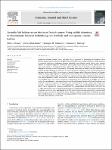Item Infomation

| Title: | Juvenile fish habitat across the inner Danish waters: Using otolith chemistry to discriminate between hybridising con-familials and contiguous, coastal habitat |
| Authors: | Brown, Elliot J. |
| Participants: | Reis-Santos, Patrick Gillanders, Bronwyn M. Støttrup, Josianne G. |
| Issue Date: | 2019 |
| Publisher: | Elsevier |
| Series/Report no.: | Estuarine, Coastal and Shelf Science, Volume 220, 2019, Pages 111-119 |
| Abstract: | Connectivity between juvenile habitats and adult stocks is important for determining the resilience of local fisheries and the relative contribution of different juvenile habitat areas to adult populations. Otolith chemistry is commonly employed to differentiate between individuals from different juvenile habitat areas; whereby different environmental exposures, mediated by intrinsic physiological processes, produce different trace element concentrations in the biologically inert otolith. This study aims to determine if otolith chemistry can differentiate between juveniles of hybridising con-familials where they are found in the same habitat and to establish if otolith chemistry can effectively re-assign individuals to contiguous coastal juvenile habitat areas of the inner Danish waters (IDW). Sympatric pairs of juvenile European plaice (Pleuronectes platessa) and flounder (Platichthys flesus) caught together in a juvenile beam trawl survey, in areas where the two species hybridise, were used to address the first aim. Juvenile plaice and common sole (Solea solea) caught during the same survey were used to determine if otolith chemistry can correctly re-assign individuals back to contiguous coastal juvenile habitat areas. Laser ablation inductively coupled plasma mass spectroscopy (LA-ICPMS) was used to analyse the trace elements in edge spots of juvenile otoliths and Canonical Analysis of Principal Coordinates was employed to test the reassignment of individuals back to correct species or area. Using a suite of eight trace elements, ∼72% of individual plaice (∼70%) and flounder (∼73%) were correctly identified. Greater than two-thirds (∼67%) of plaice were correctly re-allocated to four juvenile habitat areas and close to four out of five (∼79%) individual sole were correctly re-allocated to three juvenile habitat areas. These results indicate that the hybridising con-familial plaice and flounder of the IDW warrant further attention and could be a valuable model system to assess how intrinsic and extrinsic factors influence elemental incorporation. Furthermore, this study shows otolith chemistry is a valuable tool for tracing marine fish back to juvenile habitat areas, even where they are found along contiguous coastal areas. |
| URI: | http://tailieuso.tlu.edu.vn/handle/DHTL/8382 |
| Source: | http://www.sciencedirect.com/science/article/pii/S0272771418307984 |
| ISSN: | 0272-7714 |
| Appears in Collections: | Tài liệu hỗ trợ nghiên cứu khoa học |
ABSTRACTS VIEWS
33
VIEWS & DOWNLOAD
2
Files in This Item:
Bạn đọc là cán bộ, giáo viên, sinh viên của Trường Đại học Thuỷ Lợi cần đăng nhập để Xem trực tuyến/Tải về
Items in DSpace are protected by copyright, with all rights reserved, unless otherwise indicated.
